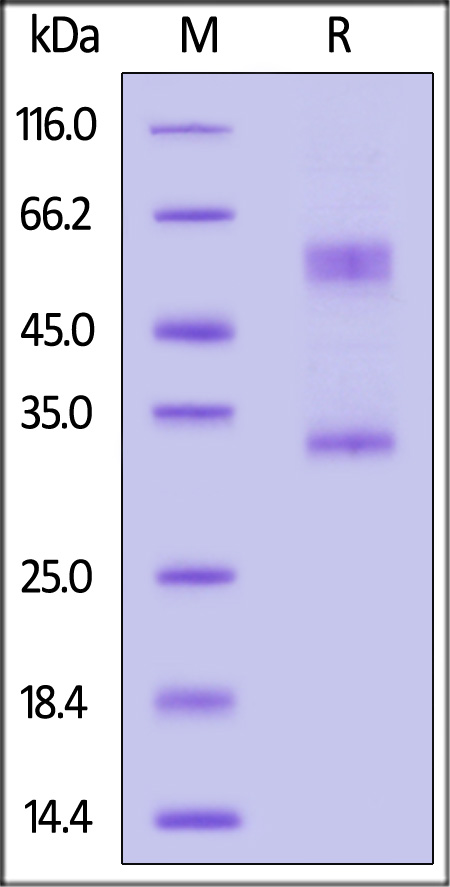分子别名(Synonym)
MAGP2,MAGP-2,MAGP2,MFAP-5,MFAP5,Microfibril-associated glycoprotein 2,MP25
表达区间及表达系统(Source)
Human MAGP-2, Fc Tag (MA2-H5254) is expressed from human 293 cells (HEK293). It contains AA Ile 22 - Leu 173 (Accession # Q13361-1).
Predicted N-terminus: Ile 22
Request for sequence
蛋白结构(Molecular Characterization)

This protein carries a Fc tag at the C-terminus. This protein contains a furin convertase cleavage site, 149-RRLR-152, and will be partially processed into N and C-terminal fragment with calculated MW of 43.7 kDa and 29.1 kDa respectively. The protein migrates as 55-66 kDa and 30-35 kDa under reducing (R) condition (SDS-PAGE) due to glycosylation.
内毒素(Endotoxin)
Less than 1.0 EU per μg by the LAL method.
纯度(Purity)
>95% as determined by SDS-PAGE.
制剂(Formulation)
Lyophilized from 0.22 μm filtered solution in PBS, pH7.4. Normally trehalose is added as protectant before lyophilization.
Contact us for customized product form or formulation.
重构方法(Reconstitution)
Please see Certificate of Analysis for specific instructions.
For best performance, we strongly recommend you to follow the reconstitution protocol provided in the CoA.
存储(Storage)
For long term storage, the product should be stored at lyophilized state at -20°C or lower.
Please avoid repeated freeze-thaw cycles.
This product is stable after storage at:
- -20°C to -70°C for 12 months in lyophilized state;
- -70°C for 3 months under sterile conditions after reconstitution.
电泳(SDS-PAGE)

Human MAGP-2, Fc Tag on SDS-PAGE under reducing (R) condition. The gel was stained with Coomassie Blue. The purity of the protein is greater than 95%.
背景(Background)
MAGP-2 (Microfibril-associated glycoprotein 2), also called MFAP5 (microfibrillar associated protein 5) is a secreted, cell-associated 25 kDa mammalian member of the MFAP family of proteins. Both MAGP-1 and MAGP-2 bind and covalently crosslink Fibrillin-1 and -2 through the Cys-rich binding domain. Functionally, the MAGP-2 RGD motif binds to the integrin alpha v beta 3, allowing cell attachment to microfibrils. MAGP‑2 is thought to facilitate microfibril assembly and induce elastin fiber formation. Through its binding to EGF repeats, MAGP‑2 mediates the metalloproteinase-dependent release of Jagged1, and the metalloproteinase-independent release of Notch extracellular domains. In endothelial cells, MAGP-2 promotes angiogenic sprouting by inhibiting Notch signaling, by binding to integrin alpha v beta 3 (which then enhances VEGF signaling), and/or enhancing the endothelial cell response to FGF basic and EGF. In ovarian cancer, MAGP-2 expression is associated with cancer cell survival, increased microvessel density, and poor prognosis.






















































 膜杰作
膜杰作 Star Staining
Star Staining











